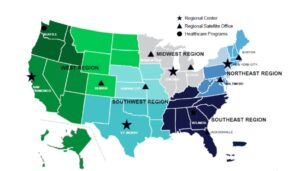FAQs
These FAQs include frequently asked questions in the real estate finance industry as they pertain to HUD financing
HUD refers to the U.S. Department of Housing and Urban Development and is a government agency responsible for promoting and ensuring fair housing opportunities, improving communities, and providing affordable housing options for individuals and families in the United States. HUD administers various programs and initiatives related to housing, community development, homeownership, rental assistance, and housing finance, among others.
In order to qualify for HUD multifamily housing, the project must consist of 5 or more units.
Typically, HUD looks to a third-party lender and matches its loan amount after two years of that loan being outstanding. These two years are referred to as seasoning.
In a typical 223(f) refinance/acquisition loan, a Physical Condition Needs Assessment (PCNA), Phase I Environmental Report, and appraisal report are needed. For a 221(d)(4) new construction project, a market study, Phase I environmental report, appraisal, and architectural/cost review are needed.
Graphic taken from https:// www.hud.gov/ program_offices/ housing/ mfh/ hsgmfbus/ abouthubspcs

At the outset of a transaction a FHA number is requested and assigned by HUD. This is an identifier that links the project within the HUD system.
A concept meeting increases the assurance that a proposed HUD loan will be approved by HUD during their review. A preliminary concept meeting discussion with HUD is only required for a 221(d)(4) transaction, and otherwise is optional.
Depending on HUD’s variability it has historically taken two to four weeks.
HUD loans are typically rate locked upon receiving a firm commitment from HUD. There is the ability however to early rate lock a HUD loan which would then be at the time of application for an additional fee.
An early rate lock refers to a provision or option provided by mortgage lenders that allows borrowers to secure a specific interest rate for their mortgage loan before the loan closes or within a certain timeframe. Typically, mortgage interest rates fluctuate daily based on market conditions, and an early rate lock enables borrowers to protect themselves from potential interest rate increases during the loan processing period.
HUD loans typically have a ten-year step down which involves a 10% percent pre-payment penalty on the first year, 9% on the second year, 8% on the third year and so forth until burn off every year decline by 1%, However, we have the ability to customize a prepayment penalties for a fee.
Custom prepayment penalties are shorter in duration than the typical 10-year step down and can be adjusted to meet the intended term of the borrower.
Typical 223(f) loans have a 35-year term and typical 221(d)(4) have a 40-year term. However, in both cases the terms can be adjusted and reduced as requested by the sponsor.
Depending on multiple factors including the volume of loans that HUD is currently processing, the speed of the lender, and the responsiveness of a sponsor.
Depending on multiple factors including the volume of loans that HUD is currently processing, the speed of the lender, and the responsiveness of a sponsor. Historical averages for 221(d)(4) closings are close to 12 months.
Historical averages for 223(a)(7) closings in approximately 90 days.
Historical averages to close a 223(f) are approximately 6 months.
HUD loans require an application fee of 30 basis points (reduced to 10 basis points if the project is located in a Qualified Opportunity Zone) due at submission and credited at closing. Additional closing costs are lender legal, borrower legal, and financing fees which are typically 1%. Third party vendors and closing costs can exceed $30,000 dollars.
